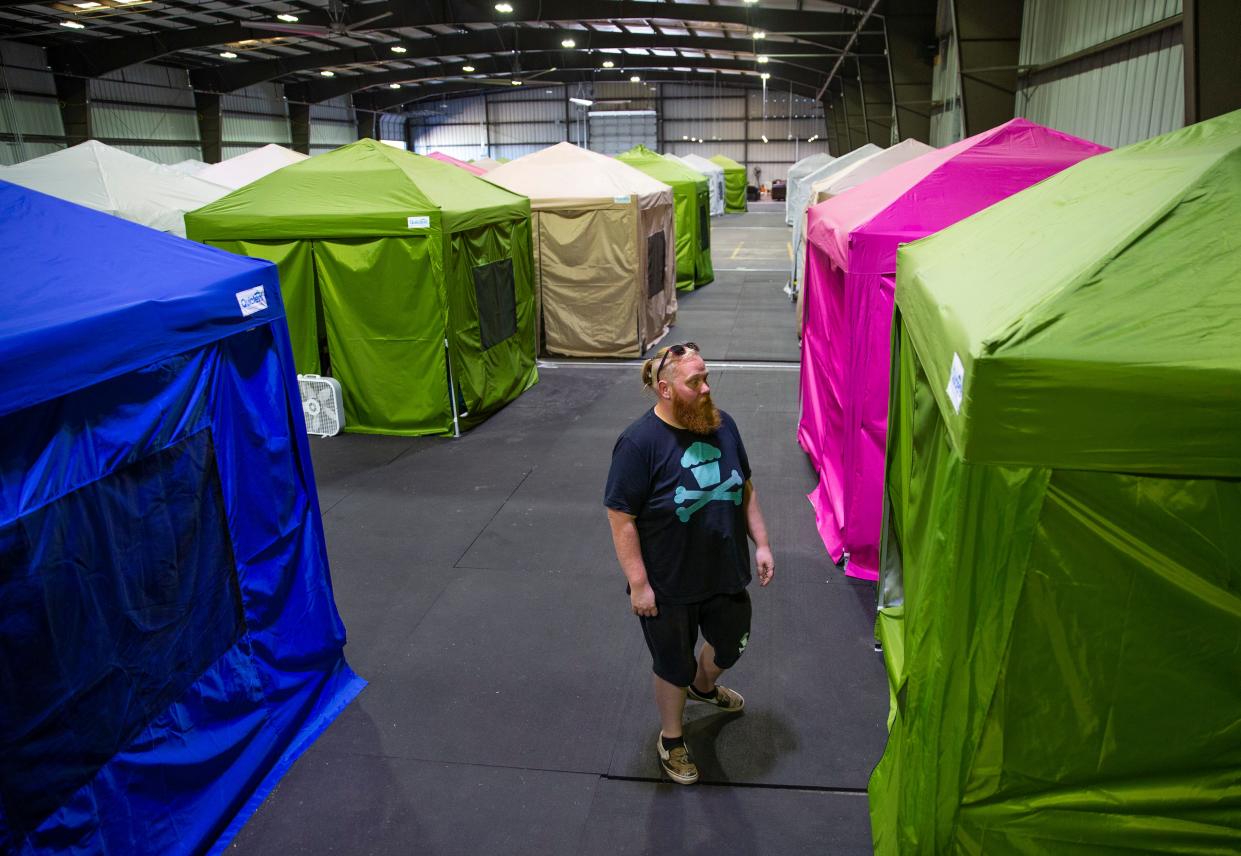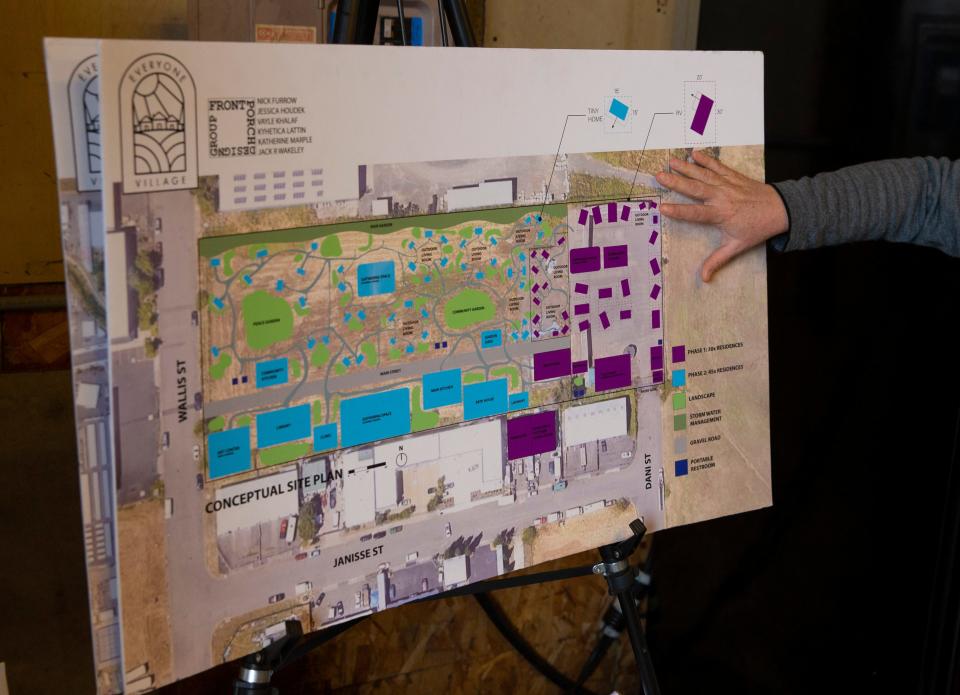How Lane County plans to divvy up $18 million this year to address homelessness

Lane County commissioners plan to spend $18.4 million from the state's 'All-In' program created under Gov. Tina Kotek's declaration of emergency due to homelessness to prevent 1,296 households from becoming unhoused, add 319 shelter beds, rehouse 600 households and provide street outreach to 115 people by the end of the year.
Kotek allocated money to five regional governments: Portland Metro, Marion/Polk counties, Central Oregon, Lane County and Jackson County, and assigned each region numerical goals to hit by the end of the year. Lane County aims to overshoot its state-assigned goals of preventing 741 households from becoming unhoused, adding 230 shelter beds and rehousing 247 households.
The money came with the requirements that the programs funded must be new as opposed to being directed to existing programs. The emergency shelters also must be funded to operate 24/7, as opposed to only beds used for extreme weather. The money must be spent by Jan. 10, according to Lane County Interim Health & Human Services Director Kate Budd.
Commissioners have praised the work of county staff on putting its plan together.
"It (homelessness) is such a complex problem and you guys do a great job of breaking it down," Commissioner Ryan Ceniga said. "I saw different programs … that I think will do great. Especially emergency shelters if you can get more beds in there."
The county put out requests for proposals to meet the goals, and assessed applications from local nonprofits. The county is divvying up the state money among itself and 17 nonprofits including St. Vincent de Paul.

The need is high, but the money will help, said Terry McDonald, St. Vincent de Paul's executive director.
"We would like to make sure that there's no homelessness at all and that there is no family or individual that is unhoused, but given the scope of the problem … and how many homeless there are in Lane County, the likelihood of that eventuality of having everyone housed is unlikely," McDonald said.
"But there are things that are the most effective tools that we have and we're willing to prioritize," he said. "So whether it's making sure that there's opportunity for emergency housing for families … (or) helping families move on out of homelessness back into stability, we want to be able to provide that."
Unhoused need in Lane County
The county's homelessness dashboard says 4,531 people in Lane County were unhoused as of June and 19% of those individuals were sheltered.
The dashboard relies on its homeless-by-name count, which is considered a more accurate count than the Point-In-Time Count required by the federal government.
Another new county dashboard is on shelter inventory and says there are 704 emergency shelter beds in the county that meet the HUD definition, and that combined they were operating at 82% capacity.
There were an additional 570 spots in alternative shelters, such as camping programs and Conestoga huts, 80% were being used. The inventory also shows 196 households were given rapid re-housing vouchers and, 84 households were on a waitlist.
Protecting as many people as possible
Those capacity levels are influenced by some shelters operating under capacity because they want to ensure there are beds for specific populations. Mainstream Housing, for example, has had seven openings for most of June reserved for adults with intellectual disabilities.
More general shelters like St. Vincent de Paul's 410 Garfield Safe Sleep Site has a 1,200-person waitlist, which McDonald hopes to reduce with the state funds.
"The opportunity to solve the (long-term) problem is less important than trying to find a way to prioritize the limited resources to do the most effective process we can to protect as many people as possible," he said.
Heather Quaas-Annsa, philanthropy director at Community Supported Shelters, criticized the restrictions that All-In money couldn't be combined with existing funds and it's temporary nature. "We don't want to create a new program only to shut it down six months later," she said of CCS's decision to not apply. "It's not fair to staff or clients."
Budd said that in the time since the county put out its applications for All-In money, the Legislature passed SB 5511, which will allow regional governments to keep receiving money through 2025.
"That's very exciting because for basically the first six months of knowing about the All-In dollars and this whole effort, we thought we might be facing a very significant cliff where the $18 million would just end," Budd said. "While we don't know the exact amount, we do know that many of our All-In investments will be able to continue."
How the Money's Allocated
The county is breaking up the All-In dollars between itself and 17 nonprofits, working toward the following goals:
Homeless Prevention
About $2.4 million will go to programs designed to prevent people from becoming homeless, including:
$888,000 in flexible funding toward diversion programs, such as food assistance, so someone can keep paying rent, to keep 592 households housed
$887,500 in rent assistance to keep 355 households housed
$25,000 targeted at keeping 10 youth households housed
Emergency Shelter Beds
About $4 million toward creating more unhoused shelter beds, which includes:
$2.1 million to improve 186 beds at alternative shelters (places that serve as unhoused shelters but do not meet the HUD definition) such as Carry it Forward and Everyone Village. Jason Davis, spokesperson for Lane County Health and Human Services, said this still results in more beds. "I know it can be confusing when you read the plan and you see that money going into existing shelters to improve them, well that's an existing shelter that's not able to actually house individuals right now and/or a shelter that is not utilized to its greatest capacity and efficiency."
$225,000 to add 15 beds for people discharged from the hospital
$272,000 to provide 16 beds in rural severe weather shelters
$171,000 to add 10 youth shelter beds
$170,000 to add 10 family shelter beds
$1 million to add 82 beds to existing shelters

Rehousing and street outreach
About $9.4 million will go to programs designed to rehouse people such as rent vouchers and street outreach to get people connected to services.
$3.7 million for rapid response and diversion programs such as Lane County Coordinated Entry to rehouse 372 households
$550,000 to hire street outreach staff to rehouse 55 households
$2.7 million for rapid rehousing vouchers to rehouse 133 households
$600,000 for urban housing navigation assistance to rehouse 60 households
$1.9 million for rural housing navigation assistance to rehouse 95 households
Systemic work
The remaining $2.7 million will go to administrative costs and a list of systemic priorities that include:
Staff and nonprofit outreach to camps
Master leasing initiatives, which are programs where agencies rent housing and sublet it to people
Increased connections with local culturally specific agencies that provide services, such as Central Latino Cultural
Easier entry points into programs, including improving 211, the United Way hotline meant to connect people to a range of services including housing and shelter navigation
An incentive program for landlords to accept unhoused tenants
Skills training for All-In providers
A dashboard to track outcomes
Alan Torres reports on local government for the Register-Guard. He can be reached by email at atorres@gannett.com and twitter @alanfryetorres
This article originally appeared on Register-Guard: Lane County plans to divvy up $18M to address homelessness

